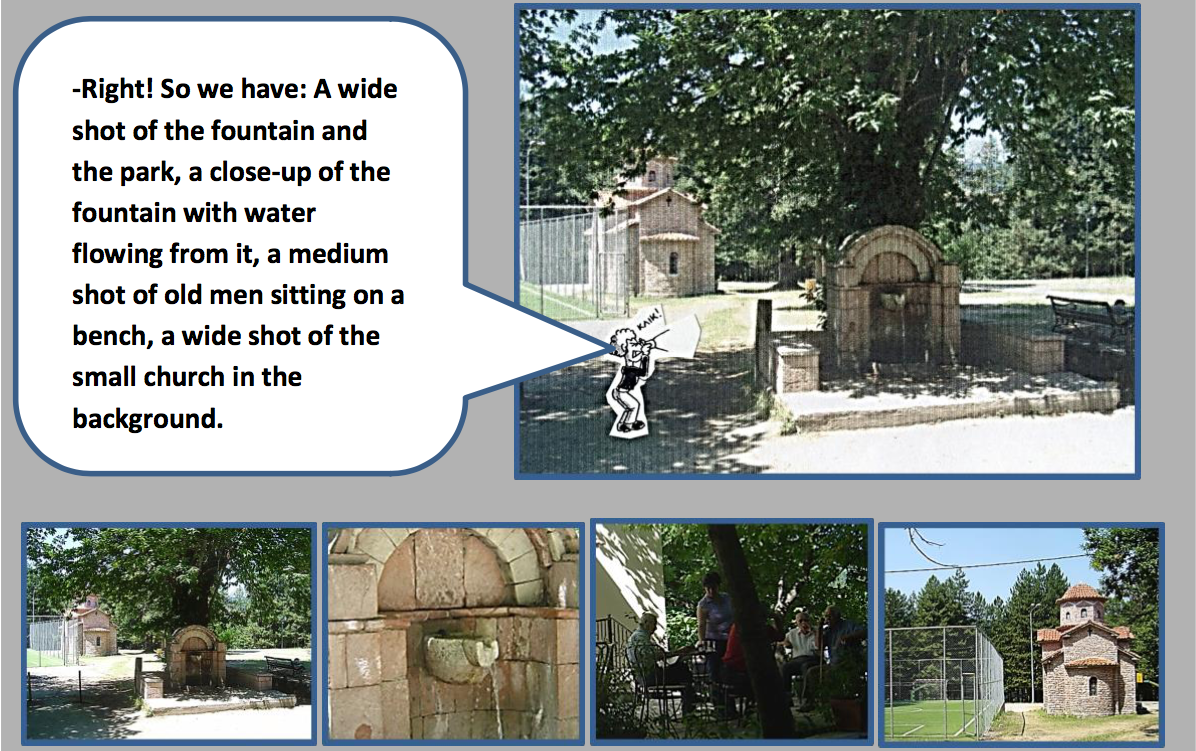Describing a public place
This is a simple, introductory activity referring to two of the most determining parameters of audio-visual expression, namely framing and juxtaposition of shots. It also elaborates on the concepts of documentation and the inevitable subjectivity related to any visual description of a place, as this always represents a personal view resulting from the creator's choices. Overall, this activity encourages the development of collective competences of communication between group members during the realization of a common product.
Material needs: one simple still camera or tablet/ smart phone for each group, a laptop to edit each group's presentation and a projector for screening final presentations. A color printer can be useful for printing photo descriptions for an exhibition.
Step by step procedure: The group is divided in smaller groups and they all consider the short introduction explaining the basic frames and shots of a media text. This very simple system of categorizing shots for the purposes of photographic documentation can be utilized by young participants every time they visit places, monuments etc. During this activity, the group could be split up into several small groups of three-four participants, with each group being responsible for choosing and describing a specific area by shooting two wide, two medium and five close-up shots.
After the participants form small groups of three-four members, the educator explains the object and the rules of the activity. Members of each team then collaborate in order to present one final team result rather than a portfolio of separate personal projects. The procedure for most activities requires that:
- Each member of the team will participate in the activity. As a start, each member of the group will contribute a personal suggestion as to "what should we choose to shoot?" (brainstorming). In media-experienced groups, this step might include indicative, rough photos by each member. Team members discuss each other’s suggestions and the way each could be integrated in the group's project.
- Team members ‘negotiate’ with each other and agree on the collective shooting that will represent their team’s final product (as in the photo example below). In a public park, "are we going to focus on some litter in a corner, or on a beautiful collection of plants in another corner, or on some children playing around?" Each group may decide differently.
- Collective shooting, according to the agreed plan. The assignment is to "describe a specific public area by shooting two wide, two medium and five close-up shots". This may require a number of alternative shots for each of the images that will be finally used in the group's visual description.
- Later on, back in the working area, the members of each group will decide on the sequential arrangement of their photos, and may also add comments/captions in order to present their own opinion regarding the area described. To reach to their final product, group members will argue regarding the selection of the most successful photos, the order of presenting them, the content of any possible captions as well as the mode of their presentation (projection of the photos one after the other in a kind of a PowerPoint or printed photos and written captions exhibited on a wall).
- Each team presents its final result to all the other groups, after which a discussion focusing on any possible similarities and differences that might have occurred between the groups takes place.
- Each team is evaluated by all other teams using criteria that have been determined in advance (such as clarity, originality, well-rounded opinions, articulation of conclusions and proposals, etc.).
Apart from the audio-visual competences developed in this kind of activity, an effort is being made to offer opportunities to realize how many different points of view can emerge facing one and the same subject, thus realizing the value and the dangers of mediation.
Alternatively, as a larger group, participants could combine all the wide, medium and close-up shots and then collectively decide upon a new presentation of their visit by choosing and using two wide, two medium, and five close-up shots that represent their documentation of the place as a whole. Also the whole presentation could be supplemented by some sound recording including on-the-spot recorded sounds, music, commentary etc.

Hints for facilitators / Comments:
Assigning the same topic to a number of small groups is a pedagogical option commonly chosen by educators. That is, assigning the photo recording of the same public place (square, open market, mall, train station, historic sight) to all small groups may reveal the different points of view that emerge on a common theme.
Mediation is one of the most important characteristics of social organization and culture and a practice in which we are constantly engaged. For example, education as a whole constitutes our mediated relationship with knowledge, an artist-mediator invites us to view the world from his/her perspective, our political life is primarily based on politician-mediators representing us in decision-making centers, while acquiring information about current events requires at least some partial acceptance of a journalist-mediator who researches, observes and judges “on our behalf”. On the one hand, the act of mediation (enabling us to be informed about a subject) is based on our trust of whomever we choose as our information source-mediator. On the other hand, we must always remember that while the mediator’s personal perspective aids us in our understanding of the subject in question, it in fact constitutes a selective view of that subject. For that reason, we must always use our critical judgment when receiving information through a mediator.
The publication was created as part of the project: EMELS.
This publication reflects the views only of the author, and the Commission cannot be held responsible for any use which may be made of the information contained therein.

